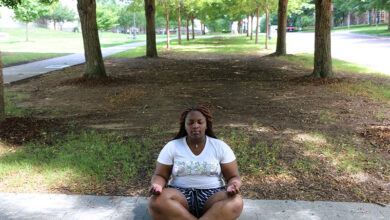Arkansas town known as ‘gathering point for KKK’ works to re-brand itself toward black community who say they’re still fear getting hung

When a black man supposedly broke into a white man’s home in 1905, a mob ran most black people out of town – and instantly gave this community a lasting reputation as being too dangerous for minorities.
More than a century later, only 34 of the nearly 13,000 residents in Harrison are black. But the town desperately wants to overcome its past, hoping a better image will attract more residents and businesses.
Leaders are now advocating for diversity in a way rarely seen in overwhelmingly white places: creating a task force on race relations, printing posters about the city’s ugly history and bringing in a civil rights speaker.
‘If your image is out there that you’re this little racist enclave set in the hills, who you going to attract? You’re going to attract racists,’ said Layne Ragsdale, a member of the task force.
It’s a hard sell. The task force is almost all white. The posters go into storage between events. And the town had to bus in black children to listen to the speaker.
Harrison’s tiny black population is actually larger than it used to be. For decades after race riots in 1905 and 1909, fewer than 10 black people lived here or elsewhere in Boone County, a largely rural square of northern Arkansas where residents only recently voted to allow alcohol sales.
The town’s history of racial conflict
isn’t unique in a state where federal troops had to escort a group of
black students known as the Little Rock Nine into Central High School
during a historic 1957 clash over desegregation.
But Harrison stands out because the town pushed out virtually its entire black population.
‘They chose to run their African-American population off,’ said John Kirk, a history professor at the University of Arkansas at Little Rock who has written about the state’s racial past. ‘How do you reconcile with a population that’s not there anymore?’
Before the riots, more than 140 black people lived in the county. Then tensions started brewing as work dried up on the nearby railroad line.
In 1905, the white mob that ran off most of the black population burned down homes and shot out windows. Many black people left, and those who stayed fled in 1909 after a black man was convicted of raping a white woman.
Only one black woman, known as Aunt Vine, stuck around. The task force on race relations named its scholarship for minority students in her honor.
Harrison leaders hope eventually to welcome back descendants of those who fled. And maybe that will show the town isn’t so racist anymore.
‘Getting the truth out there will do nothing but help us from a business perspective,’ said Chris Ramsey a member of the task force and sales director for Harrison’s convention and visitors bureau.
Businesses that declined to locate in
Harrison have not explicitly cited the community’s racial history, but
it’s an issue that has to be addressed whenever a company is courted.
Over
the years, the city has attracted enough industry to keep Harrison
alive. People here make whiteboards, aluminum parts for barbecue grills
and wood floors for tractor-trailers. Tourists stop here, too,
especially bikers who ride along the curvy roads of the Ozark Mountains.
But they, like nearly everyone else here, are white.
Confederate
flags aren’t hard to find and, until recently, neither was a moveable
barbecue joint called Kracker’s. That smoker has since disappeared,
unlike the Ku Klux Klan, which reinforced Harrison’s racist legacy. The
leader of a Klan group called the Knights Party lives outside Harrison
and maintains a post office box in the city.
‘There are racists in every community,’ Ragsdale said. ‘Ours are more vocal than some.’
Still, no one has done anything to stop the Klan group from organizing an event that sounds a lot like a rally – ‘Open to ALL Concerned White Patriots’ – later this month.
‘What do you want to do, run him out?’ asked Mel Chaney, who lives south of Harrison. Chaney, who is white, said he had never seen any signs of racism in town. Neither had Bill Sloss, who is also white.
‘How can it be a racist town if there’s no blacks here?’ Sloss asked.
Others disagree. Rumors of discrimination persist here: a restaurant refusing to serve a black man, racial slurs that roll off people’s tongues.
‘The reality is that Harrison remains today something of a gathering point for white supremacists,’ said Mark Potok, a senior fellow at the Southern Poverty Law Center.
That reputation scared some of the black students who came here last month for a nonviolence summit.
Maria Oates had to convince her mother to let her travel to Harrison. Even when her mother consented, Oates was apprehensive about the trip.
‘I was nervous up until I actually got there and talked with the people that live there,’ Oates said. She said she would return for another community service project, but not on her own.
Other students were blunter about their fears.
‘They told us they thought they were going to be hung,’ Ragsdale said.
After the students left, Oates was talking to her dad about a piece on the Klan in the local news.
‘After I heard that, I kind of thought, `What if they really didn’t want to change?”























































